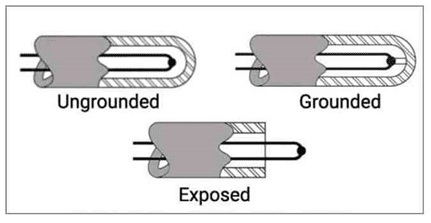In this article, we will discuss some of the important temperature measurement interview questions and answers(RTD and Thermocouple).
Q.1 What are the different elements used to measure the temperature?
The following primary sensors are used to measure the temperature.
- RTD
- Thermocouple
- Thermistor
- Bi-metallic temperature indicator
- Pyrometers
Q. 2 What are different temperature units?
- There are 3 different units of temperature which are widely used
- Degree Centigrade
- Degree Fahrenheit
- Kelvin
Q.3 What is the relationship between Degree Centigrade, Degree Fahrenheit, and Kelvin?
- Degree Fahrenheit = (9/5 * Degree Centigrade) + 32
- Kelvin = Degree Centigrade + 273.15
- Kelvin = 273.15 + ((Degree Fahrenheit – 32) * (5/9))
Q.4 What is the output of RTD?
- The output of RTD is in terms of resistance change.
Q.5 What is RTD?
- RTD stands for Resistance Temperature Detector. RTD is a temperature sensing element that has a sensing metal made up of Platinum (the most commonly used one), gold, silver, nickel, or copper. A change in the temperature will create a change in the resistance of the RTD i.e. rise in the temperature will increase the resistance of the RTD. The resistance change is used to determine the temperature change.
Q. 6 What is relationship between resistance and temperature for RTD in terms of temperature coefficient?
- The relationship between the RTD’s resistance and temperature is directly proportional. This is the reason that the RTD is said to have a positive temperature coefficient.
Q.7 How many configurations are there for RTD?
- RTD has 3 different configurations.
- 2 wire RTD configuration
- 3 wire RTD configuration
- 4 wire RTD configuration
Q.8 Which RTD configuration is most accurate?
- 4-wire RTD configuration is the most accurate RTD configuration.
Q.9 What is the relationship between the resistance and temperature in terms of formula?

- Rt = resistance at temperature t degree centigrade
- R0= resistance at a temperature 0 Deg C
- α = temperature coefficient of RTD (Per degree centigrade)
- t = temperature
Q. 10 Can we convert one type of RTD configuration to another type of RTD configuration?
- Yes, we can Convert 2 wire RTD into 3 or 4-wire RTD
Q.11 What does PT100 mean?
- PT100 is a type of RTD made up of Platinum metal. 100 means the resistance of the PT100 RTD element will be 100 ohms at 0 Deg C.
Q.12 What is the output of a thermocouple?
- The output of the thermocouple is in terms of millivolt.
Q.13 On what principle does a thermocouple work?
- A thermocouple works on the principle of the Seebeck Effect. Seebeck effect states that “whenever two different metals form two junctions, and when these junctions are at different temperatures, the current starts flowing between these junctions and a voltage develops between these junctions”.
- Whenever these two dissimilar metals form two different junctions, and both the junctions are having different temperatures, then the current will start flowing from the hot junction to the cold junction. An EMF is induced across the open end or at the cold junction. The EMF is proportional to the temperature difference between the 2 junctions.
Q.14 What should be the ideal temperature for a cold junction in a thermocouple & how do we maintain a cold junction?
- The ideal temperature for the cold junction in a thermocouple should be 0 Deg C.
- Cold junction compensation is used to maintain a 0-degree Centigrade for thermocouples having cold junctions at some other temperature.
Q.15 What are widely used thermocouple types?
- The most widely used types of thermocouples are J, K, E & T.
Q. 16 What are the types of Thermocouples on the basis of Junction?
- Based on the types of junctions, the thermocouples are grounded junction thermocouples, ungrounded junction thermocouples, and exposed junction thermocouples.

Q. 17 What are 2 different types of thermocouple leads?
- Thermocouples are generally used with leads that connect them to a distant temperature transmitter. Compensation leads and extension leads are two types of thermocouple leads.
Q.18 What is the difference between the compensation lead and extension lead in a thermocouple?
- Thermocouple compensation leads are metal leads with the same properties as the metal of the thermocouple. While the thermocouple extension leads are made up of the same material which is used for thermocouple metal.
Q.19 Which metals are used for different types of thermocouples?
- Type J Thermocouple: The positive lead is made up of iron and the negative lead is made up of constantan which has 45% of nickel and 55% of copper.
- Type- K Thermocouple: The positive lead has approximately 90% of nickel and 10% of chromium. At the same time, the negative lead has approximately 95% of nickel, 2% of aluminum, 2% of manganese, and 1% of silicon.
- Type E Thermocouple: The positive lead is made up of nickel-chromium (90% nickel and 10% chromium) and the negative lead is made up of constantan (95% nickel, 2% aluminum, 2% manganese, and 1% silicon).
- Type T Thermocouple: The positive lead is made up of copper and the negative lead is made up of an alloy of constantan which has 45% of nickel and 55% of copper.
Q.20 What is the temperature measurement range of different types of thermocouples?
- Type J Thermocouple: -190 Deg C to 760 Deg C
- Type- K Thermocouple: -190 Deg C to 1371 Deg C
- Type E Thermocouple: -190 Deg C to 1000 Deg C
- Type T Thermocouple: -270 Deg C to 300 Deg C
The above temperature measurement interview questions and answers are generally asked in interviews, tests, and viva.
good questions very helpful